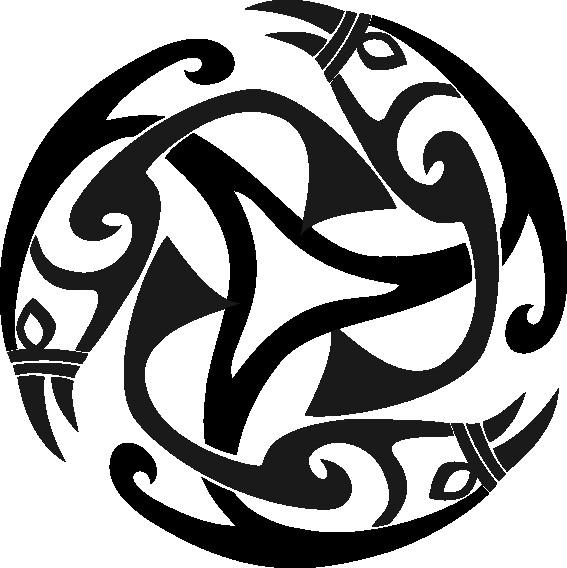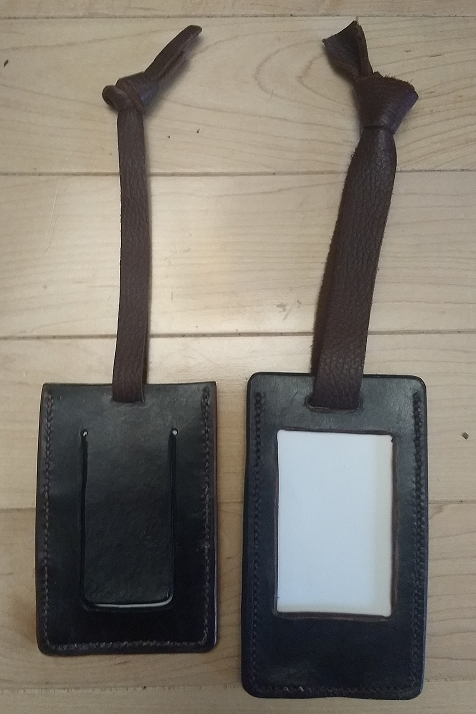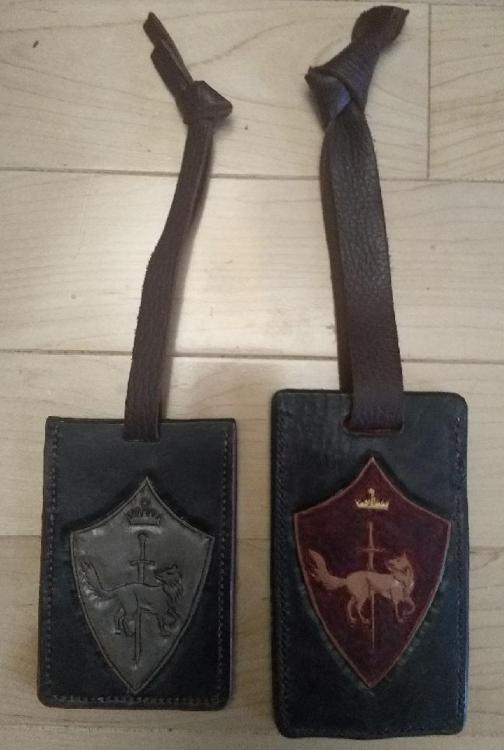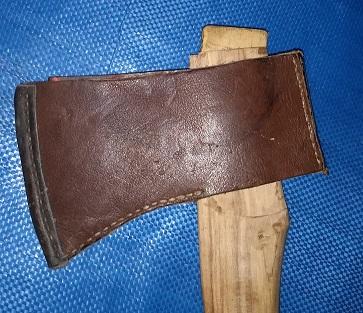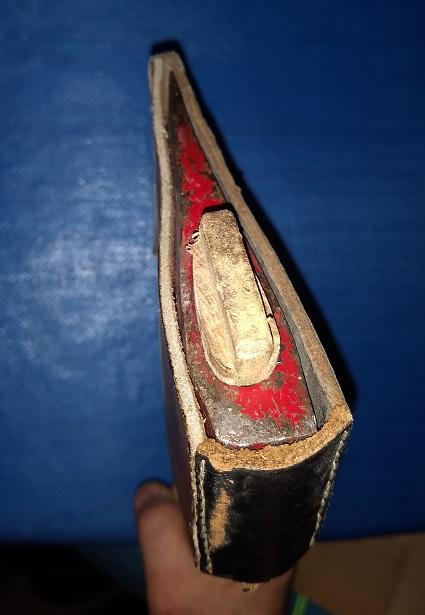-
Posts
1,091 -
Joined
-
Last visited
Content Type
Profiles
Forums
Events
Blogs
Gallery
Everything posted by DJole
-
Where did you get a sewing machine small enough to make that boot?! ;-)
-
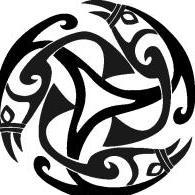
Watch straps and card holders
DJole replied to Danne's topic in Purses, Wallets, Belts and Miscellaneous Pocket Items
Nice work! Tell me about that pink leather -- where's it from? It sure is striking. -
Welcome to the forum! Lots of friendly people here ready and willing to share information about any questions or problems you may have. If you're interested in saddle making, there are professional saddlers here that you can talk with.
-
heh! She tried to be so helpful!
-
Nice work on the textured bevel! Looks like you've got that technique down.
-

First Leather Project
DJole replied to ChipperBags's topic in Purses, Wallets, Belts and Miscellaneous Pocket Items
Nice work for a first-time piece! It really does seem that the blood sacrifice is necessary, though I don't understand why... I just wonder about those straps, sewn to the body of the bag -- will those sewing joints hold up under the strain of a loaded bag? Or would it be better to reinforce them with rivets or the like? I haven't made enough bags to have a definitive answer for the questions. -

Two bag tags
DJole replied to DJole's topic in Purses, Wallets, Belts and Miscellaneous Pocket Items
-
-
I did a quick overview of your website, and I found some errors in your textual information, quoted above directly from the website. You have the same text describe both tools! Aside from that... do you have video footage of your tools in action?
- 8 replies
-
- belt press
- belt punch
-
(and 8 more)
Tagged with:
-

Contact cement
DJole replied to Scottgallagher's topic in Dyes, Antiques, Stains, Glues, Waxes, Finishes and Conditioners.
I have a few tubes of the toluene-free Barge, and it seems to work fine. Then again, I don't have any of the original Barge for comparison. -
1) Sharp leather scissors are a good find! Make sure they're only used on leather, and make sure people use them safely. 2) Those rotary punches should have replaceable tube punches. If you contact a Tandy Leather in your area, they should be able to supply you with new, sharp tube punches. 3) The regular awl may need sharpening and stropping, or else it will not work correctly (and actually be more dangerous!) 4) If you've got a number of stamps, are there also mallets (rawhide or nylon) for them? 5) For best results, the variety of threads you mention need to have needles that match them in size and tools to make holes in the correct sizes. Holes, needles and thread that don't match in size are going to be very frustrating. 6) If you have X-acto knives and utility knives, you'll need a supply of fresh, sharp blades. Self healing cutting mats and the metal rulers are the correct accompanying tools. 7) The markers, if they are permanent ink (like Sharpie brand markers) are a quick and easy way to color leather. Much less complicated and messy than bottles of dye. Of course, someone will have to go through and test all those markers to see if any need replacing. 8) If the glues are too old, they'll need to be replaced. 1) Quick projects for the time frame you mention = bracelets, bookmarks, luggage/backpack tags. A search online will show a number of patterns available. 2) I can't help with your question about getting leather donations. I recommend looking at Ian Atkinson's YouTube videos. He runs Leodis Leather over in the UK, and he has a very useful set of videos. One in particular lists what tools he recommends for beginners, which are NOT specialized leather tools: https://www.youtube.com/watch?v=X1pAMZQpYFA He also sells patterns, if any of them strike your fancy. 3) Tool set list: I guess you are referring to stitching irons. It gets a bit complicated, though, since there are different kinds for different purposes, and for best results they have to match the project size, needle size and thread size. Also, for short simple projects they might require more time and expertise than you have available. They are for what is termed "saddle stitching," which is a whole other rabbit hole! 2 sets of rotary punches is good. The individual punches usually come in sets, with 5 or so tubes available. But to use them, you must have mallets and a good striking surface underneath them. leather cement is complicated -- the GOOD ones (like Barge brand, which are quick to set, hold strong) have various warnings with them due to their chemical natures. They might not work in your camp setting. Rubber cement is also used by many for leather work, but that's another one with warnings. Other glues take a while to set, which might be frustrating in the time frame you indicate for the activity. Mallets: don't get the very cheap wooden ones-- they aren't worth the money you save. The yellow nylon mallets will work fine, and they come in two different sizes, a smaller and a larger. Two of each size would probably work. Snaps and snap setters -- that depends on the project. Having a few different sizes is a good idea, and make sure that you have a lot of snaps -- they'll get mis-set a lot, and used up quickly. Grommets with a setter might not be a tool you need. Many leather projects don't use them at all. If you're pounding holes, you want a heavy stone topped with something resilient and self-healing. Don't let anybody punch holes directly over the stone! The stone is what you want for stamping, setting, and so on. The good news is that you can frequently get this for free or cheaply -- Find a place with sells and installs stone cabinet tops, and ask for scraps. I think by "edge rounder" you are referring to a belt or strap end punch. They come in either round or pointed shapes. They also come in different sizes, depending on the width of the strap, and they need to be kept sharp. Also, because they are sharp, they need to be carefully handled and stored. You might be safer off with a set of acrylic templates which you use to trace the shape on the leather and then cut with a knife or scissors. Right angle rulers are useful, for measuring, getting straight lines, and getting perpendicular lines. A couple of those would be good. Leather needles and thread -- Leather sewing is another art in itself. I myself have 5 different sets of John James harness needles (pretty much the industry standard for hand sewing), which are different sizes and lengths, with different sized eyes, to match the size of thread and size of hole for different projects. Same thing with the thread -- there are a dizzying variety of materials and colors and sizes available -- It's all complicated and expensive! For most camp-age kids, it will be a struggle to set a straight stitching line, use an iron to make the holes, and by that time, the class time is all gone! In fact, most of the projects which are realistic for your camp setting (wallets, for example, need more time than what you list) won't need a lot of sewing at all. Many ready-made kits already have holes punched, needle and thread included with the kit, to speed up and simplify the process. Most of the kits actually have round pre-punched holes, rather than the slanted or diamond-shaped holes that stitching irons make. This also means that needle and thread size are less important. Traditionally, stitching holes are made with awls, but that's a learned skill which you won't have enough time for at camp. Also, to do leather stitching well and faster, a stitching pony or horse really helps. I don't think you'll want a stitching pony for each camper... For sturdy patterns, acrylic will be durable. Just make sure nobody CUTS using the templates! Other essentials: wing dividers -- have 2 or 3. Very useful for making circles, straight lines along edges, and so on. edge beveler tools, to round the edges. Which ones to get depends on the leather thicknesses you'll be using. A strop -- stropping all the sharp edged tools will make a big difference in how smoothly they cut. Even X-acto blades can benefit. I don't have any information on this. Sorry I can't help!
-
I recently bought an Olfa rotary cutter, and I have been amazed at how easily it cuts. And since the blades are replaceable, it's easy to keep it super sharp. For straight cuts on thicker leather, the utility knife and a metal straight edge are still very good.
-

Hello Got a question about leather wallet Inserts
DJole replied to Des804's topic in Leatherwork Conversation
Maybe these folks have what you need? https://www.walletgear.com/wallet-inserts.html?utm_source=msn&utm_medium=ppc&utm_term=wallet inserts clear plastic&utm_campaign=m+mobile+insert&msclkid=3f039624855f1e4487f7f50fc4c8b8be -
Yes, you've described the basic process exactly right. You can make these bags using an additional piping layer to hide the stitches. I made a bag with piping, and took pictures of the process. Maybe it will help: http://djole.altervista.org/djole/Publications/Leather/R/RoundBag1/RoundBag1.htm
-

Hatchet sheath—any helpful advice
DJole replied to Jaxx1024's topic in Gun Holsters, Rifle Slings and Knife Sheathes
It's hard to get a good look at your edges -- you say you burnished them, but it's unclear. I think the edges need beveling and sanding before you burnish them. Is the edge really that long? If not, there's a chance that a corner could peek out the gap between the rivets and cause some damage. Here's one I threw together, just you can see what others have done. I made this axe sheath from scrap leather over 20 years ago...still going strong. Note the stitching lines -- it's open at the top so the axe just drops in, the handle going through the hole in the bottom. There is a triangular piece that is sewn in, which the axe head rests on. The front is made of three pieces-- the strip is sewn to each side, so the sharp edge isn't touching any of the thread. It could use a strap across the top (I just recently re-handled this axe -- I've been meaning to cut the wedge down, one of these days...) -

Vertical bifold wallet
DJole replied to Chux's topic in Purses, Wallets, Belts and Miscellaneous Pocket Items
Hey, practice makes scrap projects...and eventually perfect! ;-) That's a really nice job -- it must have been a big relief to get it right with that fancy black leather. -

Am I the only one
DJole replied to Gezzer's topic in Purses, Wallets, Belts and Miscellaneous Pocket Items
Nice! You're not the only one -- I have made a card wallet for my wife and a wallet for my daughter. http://djole.altervista.org/djole/Publications/Leather/K/KateWallet/KateTrollWallet.htm http://djole.altervista.org/djole/Publications/Leather/HelenaCardCase/HCardCase.htm -
Have you skived the leather to reduce bulk where the snaps are located?
-
Take a look at Rocky Mountain Leather Supply. They offer free shipping, and they will also cut and skive the hide to custom dimensions if you need that. I have bought from them many times, and they have consistently had excellent quality. <https://www.rmleathersupply.com/>
-
Run away...don't walk, just put down the swivel knife and head for the hills with your wallet and sanity intact! Just kidding -- welcome to leatherwork! Instead of burning yourself, you'll cut and stab yourself, but you'll still get to make beautiful and functional things in an ancient craft. ;-)
-
Welcome to the forum, and welcome to leather craft!
-
Many leather suppliers will skive leather to your requested thickness prior to sending it to you. (I know that Rocky Mountain Leather Supply, for example, does this.)
-

Minimalist Geometric Leather Stamps I Made
DJole replied to texasleathertools's topic in Leather Tools
That 3-D cube is great! -
Depending on where you are located, you may be able to find them in a local hardware store, like I can.
-
That's quite a find!


